The ability to get out on the open road on a cycle and push your physical and mental limits is a fantastic way to maintain optimal health.
Furthermore, it’s a sport that anyone can partake in, thanks to adaptive cycling.
However, if you’re new to this activity, it can be confusing to figure out the type of equipment you need and what to expect overall. We give you a thorough overview of the basics!
What is Adaptive Cycling?
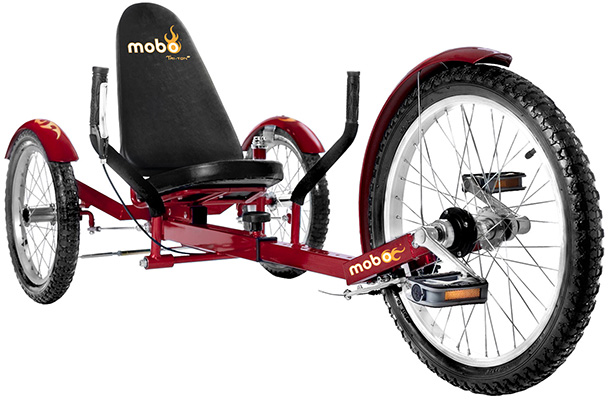
There is a vast selection of wheelchair sports that people with disabilities can get involved in, regardless of their physical limitations.
That’s the beauty of adaptive cycling, which is exactly what the name implies. You can take a set of wheels and customize the components any way you see fit to build a cycle and reap the health advantages.
There are numerous ways to get initiated into the sport, thanks to online resources, various adaptive cycling foundations, competitive teams, and recreational riding groups.
In other words, no matter what your objective is to start, there is a place for everybody.
Best of all, cycling offers participants numerous benefits, no matter the disability. For example, if balance and motor function is a challenge, adaptive biking is an ideal therapeutic solution to develop these skills.
From multiple sclerosis to cerebral palsy, Parkinson’s disease, and paralysis, the freedom to exercise is granted through this innovative sport. Let’s take a closer look at some of the benefits!
The Benefits of Adaptive Cycling
- Increases range of motion
- Promotes independence
- Improves strength to sit in an upright position
- Facilitates better blood and oxygen circulation
- Improves cardiovascular health
- Helps improve balance
- Enhances hand-eye coordination
- Develops head and torso control
- Fosters socialization
- Reduces depression, stress, and anxiety
All you need to jumpstart your adaptive cycling adventure is a cycle, which is customized to serve your specialized needs.
There are a few types of adaptive cycles to choose from. Talking to your provider and doctor can further guide you in the best ways to build the cycle to suit your physical abilities.
Different Types of Adaptive Cycles
Adaptive cycles come in all shapes and sizes, each offering a unique experience depending on your performance goals.
Tandem Cycle
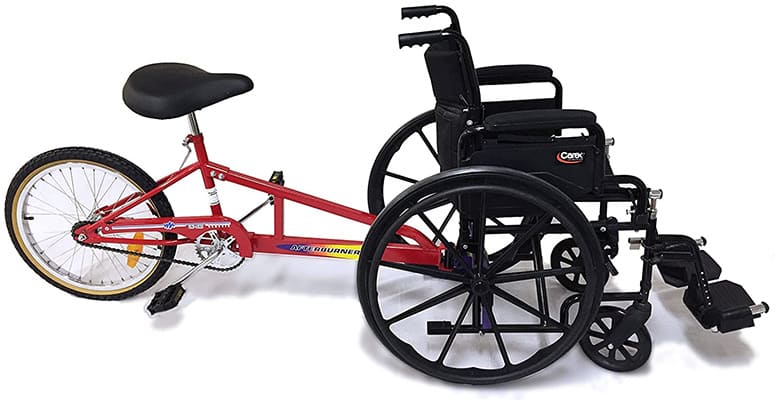
This adaptive bike is built for two people to ride, similar to what you might’ve seen for able-bodied individuals. This is a popular model for wheelchair-bound children and individuals with sight impairment.
There are a few ways the bike can be modified. Some models require the disabled rider to sit on a lower seat in the front while the companion sits on the back and handles the main propulsion and maneuvering controls.
Other models switch the rider position with the non-disabled individual handling the controls upfront.
This type of cycle reduces the risk of falls while developing balance skills. Both riders also learn how to coordinate pedaling and gear shifting together, fostering socialization and communication skills.
Hand Cycle
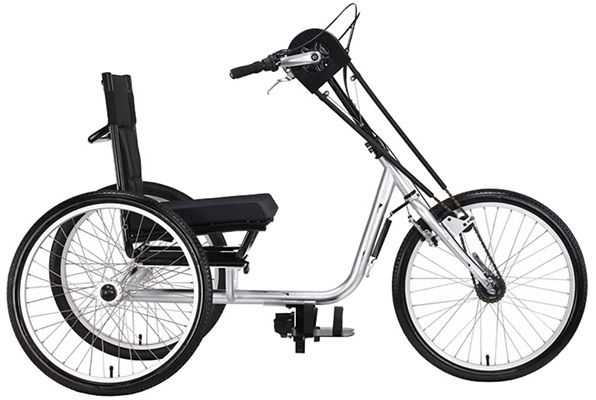
As the name implies, the handcycle is operated by the user’s arms rather than the legs. This makes it an ideal choice for those who use a wheelchair.
There are a variety of designs available that can also be mixed to create a hybrid handcycle.
Fork Steer: This is the most common model available due to its versatility. It can be used for recreation, racing, or tours. Most models come with many adjustable components, such as the footrests, gears, wheel configurations, and seat angle.
Lean Steer: This is a more advanced design, as the rider must learn how to use the body to lean into turns at high speeds.
Off-Road: This heavy-duty cycle is built to handle steep slopes and rugged terrain, like a mountain bike. Its design differs from other handcycles due to a two-wheel configuration in the front and one wheel in the back for stability. The tires are also wider for increased traction.
Racing: Built for speed, this handcycle is lower to the ground to prevent drag while allowing the rider to safely reach max lateral acceleration on a turn without rolling.
Touring: This handcycle is built for long periods spent on the road, equipped with heavy-duty gear, such as pannier cargo racks and mudguards. The design is lightweight with advanced gears for climbing slopes.
Tri-Cycle
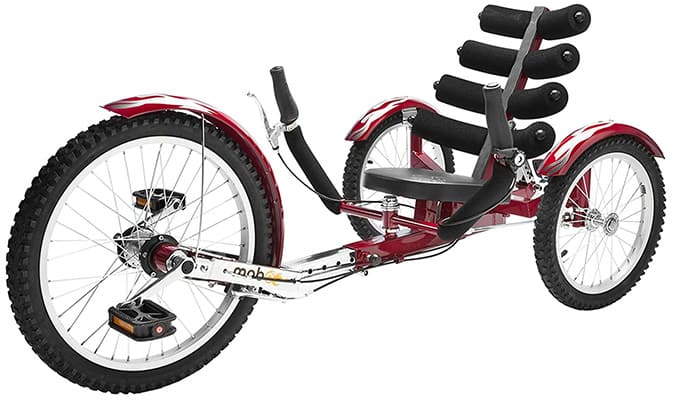
Also commonly referred to as a recumbent bike, the design places the rider in a reclined position, although upright models are also available.
This enables a person with balance difficulties to enjoy enhanced support since their weight is more evenly distributed over a larger area. Stability is reinforced further through an extra wheel on the cycle’s base.
There are two different configurations:
The Delta Trike features two wheels placed on the rear of the cycle and one steering wheel upfront. Meanwhile, the pedals power the back wheels.
This is a user-friendly model with a higher seat that is easy to mount and dismount, and a tight turning radius for stable maneuvering.
The second type is called a Tadpole Trike, with two front wheels and one back wheel. Like the Delta, the front wheels handle steering while the back wheel is propelled by the pedals.
Tadpole trikes aren’t able to achieve as wide of a turning radius as the Delta, but it does offer more stability when turning at a higher velocity.
Tadpole trikes are designed with the serious athlete in mind, featuring a shorter seat and a lighter frame for enhanced performance on distance rides.
Hybrid Bike
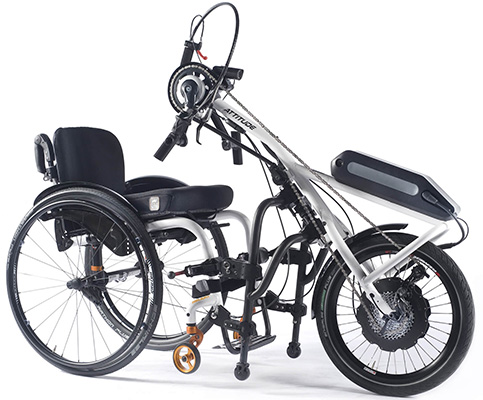
As mentioned, recumbent and handcycle designs can be fused to create a custom build, allowing the user to utilize both arm and leg power.
This offers a total body workout, even for individuals with limited leg mobility. The leg muscles are stimulated and circulation maintained through fixed gear foot pedals, even if they’re not primarily propelling the cycle. Instead, propulsion is applied via a hand crank.
What to Consider When Purchasing an Adaptive Bike
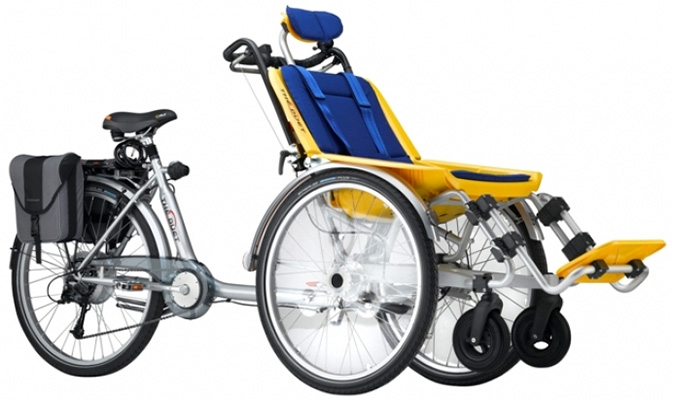
When shopping for an adaptive cycle, it’s not just about what the specific model can offer you, but also the size, materials, and positioning of various components.
Comfort and safety are always paramount, so you’ll want to pay attention to the following adaptive cycling equipment.
- Extra head or postural support: Depending on your physical needs, extra support for the spine, neck, and head areas might be a priority. There are accessories available to increase support, which can be acquired by asking your cycle provider.
- Handlebars: Most adaptive bikes feature either traditional wide handlebars that are “U” shaped, or ergonomic loop handlebars that enhance handgrip and positioning.
- Electronic assistance: For users with limited mobility, electronic accessories are available to modify certain components. This includes automatic gear shifting, reciprocators, and power assist.
- Measurements: Take time to establish the exact measurements you’ll need and discuss this with your provider or manufacturer.
- Bike hitch: Depending on your adaptive cycle model, you might have to invest in a specialized bike hitch for your car, since conventional bicycles are often smaller than say, an adaptive tricycle.
- Hydration pack: This special pack ensures you always have easy access to drinking water when cycling outdoors.
- Flag: Increase safety by mounting a bright-colored flag on your cycle to make yourself visible to drivers and pedestrians on the road.
Adaptive Cycle Cost
There’s no sugar-coating it: adaptive cycles are expensive. For example, a trike can cost anywhere between $1,000 and $5,000.
There are some ways to finance your cycle. First, check with your insurance provider to see if your policy offers any coverage for an adaptive bike. There are also many grant programs available for funding.
Final Thoughts on Adaptive Cycling
Are you ready to jumpstart your adaptive cycling training plan? Now that you know the basics, it’s time to do your own research and talk with the experts.
Contact your local adaptive cycling center or supplier and share your performance goals. They can guide you in the right direction, take your measurements, and offer manufacturer contacts.
Resources & References:
- 17 Places to Find Funding for an Adaptive Bike, Friendship Circle.
- Para Cycling, International Paralympic Committee.
- Adaptive Cycling, PubMed.